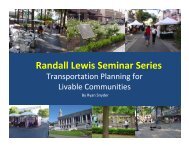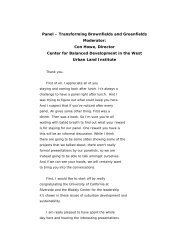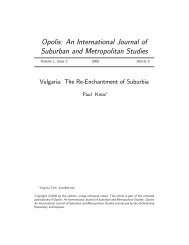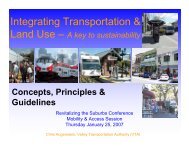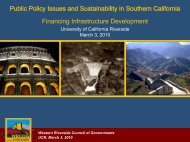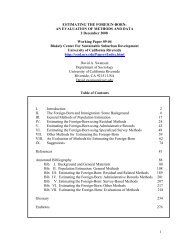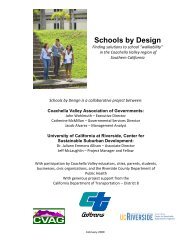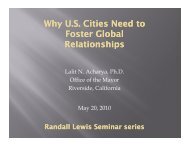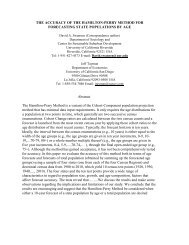Latino New Urbanism: Building on Cultural Preferences - Center for ...
Latino New Urbanism: Building on Cultural Preferences - Center for ...
Latino New Urbanism: Building on Cultural Preferences - Center for ...
Create successful ePaper yourself
Turn your PDF publications into a flip-book with our unique Google optimized e-Paper software.
are often swept aside by local<br />
governments that choose to invest<br />
large sums of tax dollars <strong>for</strong><br />
redevelopment programs that<br />
encourage displacement of <str<strong>on</strong>g>Latino</str<strong>on</strong>g><br />
residents rather than creating<br />
programs that support their<br />
revitalizati<strong>on</strong> ef<strong>for</strong>ts.<br />
As Urbanist Mike Davis (2000) has<br />
explained, throughout Cali<strong>for</strong>nia there<br />
exists a “third border” that creates a<br />
labyrinth of laws, regulati<strong>on</strong>s, and<br />
prejudices that inhibit, and even<br />
criminalize, <str<strong>on</strong>g>Latino</str<strong>on</strong>g> attempts to develop<br />
vibrant communities:<br />
...the worst enemies include<br />
c<strong>on</strong>venti<strong>on</strong>al z<strong>on</strong>ing and<br />
building codes (abetted by<br />
mortgage lending practices)<br />
that af<strong>for</strong>d every loophole to<br />
developers who airdrop oversized,<br />
“instant-slum” apartment<br />
complexes into <strong>for</strong>merly singlefamily<br />
neighborhoods, but<br />
prevent homeowners<br />
themselves from adding legal<br />
additi<strong>on</strong>s to accommodate<br />
relatives or renters. Although<br />
medium-density infill, with<br />
rental income accruing to<br />
resident homeowners, is<br />
obviously a better soluti<strong>on</strong>,<br />
even ecologically, <strong>for</strong> housing<br />
the rising low-income<br />
populati<strong>on</strong>s in Southwestern<br />
cities, it is hardly ever<br />
accommodated by law or<br />
building practice. As a result,<br />
there is a proliferati<strong>on</strong> of<br />
bootlegged, substandard<br />
garage and basement<br />
c<strong>on</strong>versi<strong>on</strong>s that keep <str<strong>on</strong>g>Latino</str<strong>on</strong>g><br />
homeowners embroiled in<br />
Mendez: <str<strong>on</strong>g>Latino</str<strong>on</strong>g> <str<strong>on</strong>g>New</str<strong>on</strong>g> <str<strong>on</strong>g>Urbanism</str<strong>on</strong>g><br />
costly c<strong>on</strong>flicts with city building<br />
inspectors.<br />
39<br />
Such border tactics have included an<br />
ef<strong>for</strong>t by the city of Santa Ana in<br />
Orange County to amend the squarefootage-per-pers<strong>on</strong><br />
standards <strong>for</strong><br />
residences, asserting that the existing<br />
regulati<strong>on</strong>s promote over-crowding.<br />
However, the court struck down the<br />
proposed change in regulati<strong>on</strong><br />
because existing standards<br />
corresp<strong>on</strong>ded with state regulati<strong>on</strong>s,<br />
while the new <strong>on</strong>es would discriminate<br />
against individuals living in the city,<br />
particularly many <str<strong>on</strong>g>Latino</str<strong>on</strong>g> families, who<br />
would not be allowed to live legally in<br />
their current homes 1<br />
Similarly, the City of Anaheim, also in<br />
Orange County, attempted to bar<br />
Gigante, a <str<strong>on</strong>g>Latino</str<strong>on</strong>g>-oriented supermarket,<br />
from a mall the city wanted to<br />
redevelop, claiming the store was “too<br />
Mexican <strong>for</strong> the surroundings” (Yoshino<br />
2002a). According to the 2000 US<br />
Census, the Anaheim census tract<br />
where Gigante wanted to open had a<br />
populati<strong>on</strong> that was more than 60<br />
percent <str<strong>on</strong>g>Latino</str<strong>on</strong>g>. The city warned the<br />
mall’s owners that Anaheim could<br />
withdraw a city subsidy because<br />
Gigante was too specialized. A city<br />
letter said the supermarket “does not<br />
cater to the public at large...product<br />
selecti<strong>on</strong> is catered primarily to the<br />
Hispanic market...store signage and<br />
music are predominantly in Spanish.”<br />
The city urged the mall owners to seek<br />
more mainstream grocery store<br />
tenants (Yoshino 2002a). Despite the<br />
city’s objecti<strong>on</strong>s, Gigante was able to<br />
sign a lease at the mall. However, the<br />
Anaheim Planning Commissi<strong>on</strong><br />
unanimously rejected the company’s<br />
1 Brazen v. City of Santa Ana, 1992, Cali<strong>for</strong>nia Superior Court No. 659206.



